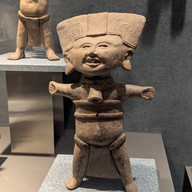The Mexico City Chronicles: Part I
- michaellatour
- Sep 18
- 3 min read
We heard a lot about Mexico City before we got here. We heard that it would be overwhelming, that we’d love it, that there’s ‘so much to do’, that it’s expansive, that it’s expensive, that it’s cheap, that it’s amazing, that it’s daunting, that traffic is a nightmare, that the museums are spectacular, etc, etc, etc.
They’re all true.
Also, in September, it rains every day- usually starting between 4pm and 5pm- sometimes drizzly, sometimes torrential- but Every. Damn. Day.
Mexico City’s urban population of 22.8 million people live in a density almost three times that of New York City’s metro area. Thus, there are many, many, many people. Almost everywhere. Almost all the time. But one of our favorite bastions for calm is the Bosque de Chapultepec (Chapultepec Forest). Over twice the size of NYC’s Central Park, this verdant urban forest houses multiple museums, a castle, food and beer gardens, the city’s zoo, multiple works of public art, and kilometers of vendors selling snacks and souvenirs. That said, a large portion of the forest is a series of paved and well-maintained walking trails, through park-like settings… with some untamed forest at the perimeter. This area has been our favorite for enjoying nature, quiet, and peace when we need a break from the never-ending museums and history.
Three Lessons in History
Museo Nacional de Antropología
The largest museum in Chapultepec is the world-renowned MNA. The 860,000 square foot structure houses over 600,000 artifacts in a brilliant piece of architecture. Focusing on the Prehistoric Era to just prior to the Spanish Invasion, its collections are immersive and interactive, using artifacts mixed with recreations to tell both the history and the story of the land and people of Mexico. Somehow, they manage to present the collection both chronologically and culturally… weaving the timeline through a wide array of societies that developed. Through the museum's creative narrative, it’s easy to see the red threads that linked these independent cultures.
I thought about trying share some of this history in this blog post, but, honestly, it would be doing this great museum, and the cultures it shares, a disservice. If you’re interested, I encourage you to seek out more reading on the Mexica*, Mayan, Teotihuacan, Olmec, Toltec, Zapotec and Mixtec cultures.
Museo Nacional de Historia Castillo de Chapultepec
Another site in Chapultepec Forest is The Castle. Originally intended as a summer residence for colonial administrators, it later became a military academy and gained national reverence during the Mexican-American War, when six young cadets—the Niños Héroes—died defending it in 1847. From 1864 to 1867, it was the imperial residence of Emperor Maximilian I and Empress Carlota, making it the only royal castle in North America to house monarchs. After serving as the presidential residence until 1934, President Lázaro Cárdenas converted it into the National Museum of History in 1939.
In its role as a museum, it almost feels like a sequel of sorts to the Anthropology Museum, picking up the narrative as the Spanish arrive, conquer, and work to assimilate the indigenous population and eradicate their cultures. It covers the fight for Mexican Independence (which, really, was the Spanish in Mexico wanting freedom from the Spanish in Spain), the battles over land with their aggressive northern neighbors, and the struggles to determine a stable form of government. But for me, the most interesting part was the architecture.
Teotihuacan Pyramids
An hour (or two, depending on that famous Mexico City Traffic) outside the city is one of the most important Archeological sites in Mexico. The Mexica Empire** first discovered the site around the year 1400. Modern day excavation began in the late 1800s, and in the 1960s there was a large restoration push, in anticipation of visitors coming to Mexico City for the 1968 Olympics.
The Teotihuacan culture flourished between roughly 100 BCE and 650 CE. At its peak, the city may have housed over 100,000 residents, making it one of the world’s largest urban centers of its time. It was meticulously planned, featuring massive pyramids, wide avenues, and multi-family residential compounds that suggest a highly organized, collectivist society. Teotihuacan was a multi-ethnic metropolis and trading capital; it exerted cultural and economic influence across Mesoamerica through trade networks that distributed obsidian, ceramics, textiles, and ritual goods. The lack of written history of the empire means that historians continue to search for clarity.
*Fun fact: Though the word ‘Aztec’ comes from a mythical place called Aztlán, the people we refer to as “Aztecs” never used that name. They were the Mexica. “Aztec” was popularized in the 1800s by (European) historians.
**Fun fact numero dos: The Mexica gave the city and its former culture the name of ‘Teotihuacan’, as no history of the site was known to them.
.png)



































































































Comments